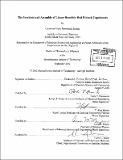| dc.contributor.advisor | Paula T. Hammond, T. Alan Hatton and Anne M. Mayes. | en_US |
| dc.contributor.author | Santini, Catherine Marie Bambenek, 1973- | en_US |
| dc.contributor.other | Massachusetts Institute of Technology. Dept. of Materials Science and Engineering. | en_US |
| dc.date.accessioned | 2005-10-14T19:25:43Z | |
| dc.date.available | 2005-10-14T19:25:43Z | |
| dc.date.copyright | 2002 | en_US |
| dc.date.issued | 2002 | en_US |
| dc.identifier.uri | http://hdl.handle.net/1721.1/29247 | |
| dc.description | Thesis (Ph.D.)--Massachusetts Institute of Technology, Dept. of Materials Science and Engineering, 2002. | en_US |
| dc.description | Includes bibliographical references. | en_US |
| dc.description.abstract | Dendrimers are three-dimensional, hyperbranched macromolecules that possess a uniform size and shape. Most dendrimers are spherical in shape; however, the shape of the dendrimer can be adjusting using the number and the position of the branching groups in the core. For example, dendritic rods have been prepared by assembling a dendron around each repeat unit of a linear polymer core, and hybrid-linear dendritic diblock copolymers have been prepared by attaching a dendron to the end functional group of a linear polymer. This linear block in the diblock copolymers also adds physical integrity and an assembly mechanism for arrangement of the polymer. Nonetheless, no one has combined the unique shape of the dendritic rod with that of the linear dendritic diblock copolymer. The objective of this research was to prepare a linear-dendritic rod diblock copolymer, and to examine its assembly behavior in solution, at the air/water interface, and in the bulk. These polymers consisted of a linear poly(ethylene oxide)-poly(ethylene imine) diblock copolymer around which poly(amido amine) branches were divergently synthesized. The dendritic branches were terminated with amine and ester groups, as well as alkyl chains of various lengths in order to "tune" the amphiphilic nature of the polymer. | en_US |
| dc.description.abstract | (cont.) A fundamental change in the assembly behavior of the polymers was observed at generation 4.0 (eight end-groups). In solution, the hydrodynamic and viscometric radii were found to increase to a much greater extent than expected for the generation 4.0 and 4.5 polymers, consistent with a breakdown of the spherical approximation as the dendritic block extended into a rod-like shape. Similarly, at the air/water interface, the dendritic block of generation 4.0-alkyl terminated polymers all adopted a horizontal rod configuration, while the dendritic block of the lower generation polymers took on a random coil configuration, whose shape depended on the length of the terminal alkyl groups as well as the generation number of the dendritic block. Finally, in the bulk, direct observation of the generation 4.0-dodecyl terminated polymer with TEM indicated that the polymer was adopting a rod- or worm-like conformation, while the lower generation polymers only exhibited traditional diblock copolymer or polymer brush behavior. | en_US |
| dc.description.statementofresponsibility | by Catherine Marie Bambenek Santini. | en_US |
| dc.format.extent | 327 p. | en_US |
| dc.format.extent | 20066211 bytes | |
| dc.format.extent | 20066011 bytes | |
| dc.format.mimetype | application/pdf | |
| dc.format.mimetype | application/pdf | |
| dc.language.iso | eng | en_US |
| dc.publisher | Massachusetts Institute of Technology | en_US |
| dc.rights | M.I.T. theses are protected by copyright. They may be viewed from this source for any purpose, but reproduction or distribution in any format is prohibited without written permission. See provided URL for inquiries about permission. | en_US |
| dc.rights.uri | http://dspace.mit.edu/handle/1721.1/7582 | |
| dc.subject | Materials Science and Engineering. | en_US |
| dc.title | The synthesis and assembly of linear-dendritic rod diblock copolymers | en_US |
| dc.type | Thesis | en_US |
| dc.description.degree | Ph.D. | en_US |
| dc.contributor.department | Massachusetts Institute of Technology. Department of Materials Science and Engineering | |
| dc.identifier.oclc | 51720529 | en_US |
